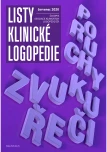PROPRIOCEPTIVE SENSORIMOTOR FEEDBACK IN THE REHABILITATION OF OROPHARYNGEAL DYSFUNCTION WITH THE USE OF PHYSIOLOGICAL MUSCLE INTERACTION – CASE REPORTS
Authors:
MUDr. Kučera Martin
Authors‘ workplace:
Ušní, nosní a krční ambulance – centrum léčby hlasových poruch v Rychnově nad Kněžnou, Svatohavelská 266, 516 01 Rychnov nad Kněžnou
; Tel. : 723 652
865
Published in:
Listy klinické logopedie 2020; 4(1): 4-12
Category:
Main topic
Overview
The author of the article has summarised his experience with the rehabilitation of combined speech and swallowing disorders in the oropharyngeal area in adults. The essence of the described therapeutic procedures is the use of the sensorimotor and physiological muscle contraction of the upper limb and muscles of the oropharyngeal region. This rehabilitative procedure allows for the whole motoric pattern (swallowing, articulation) to be worked with, and not merely its parts. The efficiency and specifics of these treatment techniques are documented in individual case reports. The author of the article is the originator of this technique.
Keywords:
rehabilitation – dysphagia – dysarthria – sensorimotor system – Proprioception – physiological parallel muscle movement Phonetic transcription – articulation disorders – transcription of Czech – IPA – speech and language therapy
Sources
- ALGHADIR, A., ZAFAR, H., WHITNEY, S. L., IQBAL, Z., 2014. Effect of chewling on postural stability during quiet standing in healthy young males. Somatosensory & Motor Research [online]. 32(2), s. 72-76 [cit. 2020-03-28]. DOI: 10.3109/08990220.2014.969837. ISSN 0899-0220. Dostupné z: http://www.tandfonline.com/doi/full/10.3109/08990220.2014.969837
- BORDONI, B., MORABITO, B., MITRANO, R., SIMONELLI, M., TOCCAFONDI, A., 2018. The Anatomical Relationships of the Tongue with the Body System. Cureus. 10(12), e3695. DOI: 10.7759/cureus.3695
- ČERMÁK, František, 2011. Jazyk a jazykověda: přehled a slovníky. Vyd. 4., v Karolinu 2., dopl. Praha: Karolinum. ISBN 978-80-246-1946-0.
- HICKOK, G., HOUDE, J., RONG, F., 2011. Sensorimotor integration in speech processing: computational basis and neural organization. Neuron. 69(3), s. 407–422. DOI: 10.1016/j.neuron.2011.01.019.
- HUDÁK, R., KACHLÍK, D., 2013. Memorix anatomie. Vyd. 2. Praha: Triton. ISBN 978-80-7387-712-5.
- KOKAWA, T., SAIGUSA, H., AINO, I. et al., 2005. Physiological studies of retrusive movements of the human tongue. Journal of Voice. 2006 Sep; 20(3), s. 414-22. DOI: 10,016 / j.jvoice.2005.08.004.
- KOLÁŘ, P., ČERVENKOVÁ, R., 2018. Labyrint pohybu. Praha: Vyšehrad. ISBN 978-80-7429-975-9.
- KUBOTA, K., NEGISHI, T., MASEGI, T., 1975. Topological distribution of muscle spindles in the human tongue and its significance in proprioception. The Bulletin of Tokyo Medical and Dental University. 22(3), s. 235-42.
- KUČERA, M., FRIČ, M., a kol., 2019. Vokologie I – Funkční diagnostika a léčba hlasových poruch. Praha: Institut pro léčbu a výzkum poruch komunikace. ISBN 978-80-265-1390-1.
- KUČERA, M., FRITZLOVÁ, K., HALÍŘ, M., 2016. Smyslové vnímání v rehabilitaci poruch komunikace. In: Senzoricko-senzitivní integrace v rehabilitaci poruch řeči a sluchu – sborník příspěvků: mezioborový seminář pro profese zabývající se rehabilitací poruch řeči a sluchu. Praha: Výzkumné centrum hudební akustiky HAMU, s. 9-56. ISBN 978-80-7331-373-9.
- MAY, A., BRAMKE, S., FUNK, R. H. W., MAY, C. A., 2018. The human platysma contains numerous muscle spindles. Journal of Anatomy. 232(1), s. 146-151. DOI: 10.1111/joa.12724.
- NOTA, A., TECCO, S., EHSANI, S., PADULO, J., BALDINI, A., 2017. Postural stability in subjects with temporomandibular disorders and healthy controls: A comparative assessment. Journal of Electromyography and Kinesiology. 37, s. 21-24. DOI: 10.1016/j.jelekin.2017.08.006.
- PASCUAL-LEONE, A., FREITAS, C., OBERMAN, L. et al., 2011. Characterizing brain cortical plasticity and network dynamics across the age-span in health and disease with TMS-EEG and TMS-fMRI. Brain Topography. 24(3-4), s. 302-315. DOI: 10.1007/s10548-011-0196-8.
- PROSKE, U., GANDEVIA, S., 2012. The Proprioceptive Senses: Their Roles in Signaling Body Shape, Body Position and Movement, and Muscle Force. Physiological Reviews. 92(4), s. 1651-97. DOI: 10.1152/physrev.00048.2011.
- SAIGUSA, H., YAMASHITA, K., TANUMA, K., SAIGUSA, M. NIIMI, S., 2004. Morphological studies for retrusive movement of the human adult tongue. Clinical Anatomy.17(2), s. 93-8. DOI: 10.1002/ca.10156.
- SCOPPA, F., PIRINO, A., 2019. Is there a relationship between body posture and tongue posture? Glosso-postural syndrome between myth and reality. Acta Medica Mediterranea. 35, s. 1897-1907. ISSN 0393-6384.
- SHUNE, S., MOON, J., GOODMAN, S., 2016. The Effects of Age and Preoral Sensorimotor Cues on Anticipatory Mouth Movement During Swallowing. Journal of Speech, Language, and Hearing Research. 59(2), s. 195-205. DOI: 10.1044/2015_JSLHR-S-15-0138.
- TODOROV, E., 2004. Optimality principles in sensorimotor control. Nature Neuroscience. 7(9), s. 907-915. DOI: 10.1038/nn1309.
- TROJAN, S., 2005. Fyziologie a léčebná rehabilitace motoriky člověka. 3. přeprac. a dopl. vyd. Praha: Grada. ISBN 80-247-1296-2.
- VAŘEKA, I., 2002. Posturální stabilita. Část 1. Rehabilitace a fyzikální lékařství. 9(4). s. 15-121. ISSN 1211-2658.
Labels
Clinical speech therapy General practitioner for children and adolescentsArticle was published in
Clinical speech therapy (Listy klinické logopedie)

2020 Issue 1
Most read in this issue
- PRIMARY REFLEXES AND THEIR INFLUENCE ON MOTOR AND SPEECH DEVELOPMENT
- ADENOID VEGETATION FROM THE POINT OF VIEW OF AN ENT SPECIALIST AND PHONIATRIST
- RHINOPHONIA APERTA & DYSPHAGIA – AFFILIATED COMPLICATIONS OF SOFT PALATE CARCINOMA TREATMENT (A CASE STUDY)
- UPPER AIRWAY OBSTRUCTION IN RHINITIS AND RHINOSINUSITIS
